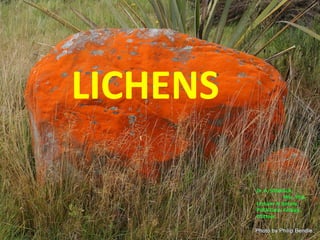
Lichens
- 1. LICHENS Dr. A. SASIKALA, MSc. PhD. Lecturer in Botany, PVKN Govt. College, Chittoor.
- 2. LICHENS Schwender (1867-68) first studied and described the relationship as helotism Anton Von DeBary (1887) described the association as symbiosis Reinke (1896) described the association as mutualism or consortium Elenkin (1902) described it as endosaprophytism Awasthi described it as polysymbiosis or parasymbiosis Ahmedjian (1962) treated the relationship as symbiosis
- 3. LICHENS Mycobiont: Fungal hphae , thallus of lichens, mostly belong to discomycetes or loculoascomycetes Phycobiont or photobiont: Algae, randomly distributed or in a separate zone, belongs to either chlorophyceae or cyanophyceae Chlorophycophilous lichen: only one phycobiont belonging to chlorophyceae Diphycophilous lichen: one chlorophycean and one cyanophycean algae
- 4. OCCURRENCE Distributed in all hospitable habitats except in chemically polluted areas (lichen deserts) Depending on the substrate lichens are of various types: 1. Corticolous lichens: Grow on tree trunks. Ex. Usnea, Parmelia 2. Lignicolous lichens: Grow on wood. Ex. Calicium, Chanetheca 3. Terricolous lichens: Grow on ground. Ex. Cladonia, Lecidea 4. Saxicolous lichens: Grow on rocks. Ex. Dermatocarpon, Verrucaria
- 9. MORPHOLOGY Crustose lichens: Thin and flat strongly attached to the substratum. Grow on bark of trees, ground and surface of rocks. Ex. Grahis, Leconora, Verrucaria, Rhizocarpon etc., Foliose lichens: Possess small leaf like branches parallel to the substratum, rhizenes are produced from the lower surface. Ex. Parmelia, Pyxis etc., Fruiticose lichens: Extremely branched like a bush, branches are cylindrical may grow upto 5 to 10 feet. Rhizenes are absent. Ex. Usnea, Cladonia, Ramalina etc., Squammulose lichens: Thallus covered with number of scales or squammules. Some species of Cladonia
- 14. ANATOMY Upper cortex: upper layer of fungal hyphae, like multiple epidermis, forms a special tissue called prosenchyma Algal zone: i. Heteromerous lichens: clear zone of algal cells ii. Homiomerous lichens: randomly distributed algal cells Medulla: Middle part of loosely owen fungal hyphae, help in translocation of water and minerals Lower cortex: only in foliose lichens, tightly owen fungal hyphae with absorptive rhizenes
- 20. NUTRITION AND GROWTH Algal partner helps the fungal partner in nutrition In some lichens fungal hyphae sends in haustoria into algal cells Carbohydrates and vitamins are transferred to fungal partner from algal cells Fungal hyphae absorb water and minerals through upper cortex and rhizenes and supply them to algal partner Growth is very slow due to the slow growing nature of its fungal partner (about 1 mm to 1cm in a year)
- 21. REPRODUCTION Vegetative reproduction: Fragmentation: When the central part of the thallus disintigrates, the peripheral parts dissociate and form new lichen thalli Soridia: bud like structures with net work of fungal hyphae, formed in groups called soralium, break through upper cortex and appear as distinct pustules Isidia: Cylindrical root like structures growing upwards with a basal constriction Cephalodia: Gall like structures with different algal members (diphycophyllus)
- 23. REPRODUCTION Asexual reproduction: Occurs only in mycobiont Flask shaped pycnidium with an ostiole is formed Pycnidiophores with spores are formed lining the inner surface of pycnidium Spores after dispersal form individual fungal colonies When come in contact with suitable algal partner form lichens
- 24. REPRODUCTION Sexual reproduction: It also occurs only in mycobiont Ascolichens: Produce ascocarps (apothecium) Female gametangium: Ascogonium with globose basal region and a long narrow trichogyne which penetrates the upper cortx and exposes on the surface Male gametangium: Antheridium or spermagonium with male nucleus Trichogyne receives male nucleus which pairs with female nucleus forming a dikaryon Then ascigenous hyphae develop, produce the asci and ascocarp is formed as in normal apothecial fungi Asci produce ascospores
- 25. APOTHECIUM
- 26. REPRODUCTION Basidiolichens: Basidiocarps are formed Corticoid lichens produce bracket like fruit bodies on tree trunks Clavarioid lichens produce erect, branching fruit bodies on wood The agaricoid lichens rarely produce fruit bodies The basidiospores disperse and produce primary mycelium, secondary mycelium and tertiary mycelium as in normal fungi Sexual reproduction is absent in deuterolichens
- 28. REPRODUCTION Reproduction in phycobiont: Algal partner normally do not reproduce, but can be induced to reproduce in laboratory conditions Show cell division, aplanospore formation, heterocysts, akinites under laboratory conditions
- 29. CLASSIFICATION Hensen and Jahns (1924),Poelt (1973) classified lichens along with fungi Alexopoulos and Mims followed poelt in classification of lichens According to this system lichens are classified into three divisions Ascolichens: Ascomycotina mycobiont, fruit bodies are either apothecium or pseudothecium Basidiolichens: Basidiomycotina mycobiont, fruit bodies are basidiocarps Deuterolichens: Do not produce any spores either asexual or sexual
- 30. IMPORTANCE OF LICHENS Ecological importance: In xerosere plant succession, saxicolous lichens play the role of primary colonizers. They carryout weathering of rocks (biogeophysical and biogeochemical) Lichens as food: Eskimos, people of Alaska and Greenland Rein deer mass – Cladonia and other lichens Braeria and Usnea – palatable for animals Lichenin: carbohydrate, reserve food material Rock flower – Parmelia species
- 32. IMPORTANCE OF LICHENS Drug preparations: lobaria pulmonaria – pulmonary diseases Parmelia sulcata – barain infections Peltigera canina – rabies Parmelia saxatilis – epilepsy Usnea, Cladonia – Usnic acid – antibiotic Sodium usnate – tomato canker Leconoric acid – tobaco mosaic Usnic acid – tobaco mosaic Other extracts of lichens – wood rotting fungi
- 33. IMPORTANCE OF LICHENS Preparation of dyes: 1. Orchil (a dye) – Rosella, Leconora – dying silk and wool garments 2. Orcinol – staining chromosomes in biology laboratories 3. Litmus dyes – Rosella tinctoria, R. montagnii Preparation of perfumes: species of Ramalina and Cladonia As pollution indicators: detect pollution due to SO2 , heavy metals and other pollutants For tanning in leather industry: Lobaria pulmonaria, Cetraria islandica Production of alcohol: species of Cladonia, Usnea, Ramalina and other lichens To detect copper and lime deposits: Species of Cetraria and leconora
- 34. IMPORTANCE OF LICHENS Harmful activities: Cedar poisoning – skin rash to wood cutters Some times interfere with physiology of host plant Spoil the stone carvings in temples Forest fires – old mans beard – Usnea species – highly inflammable
- 37. THE END
- 38. LICHENS